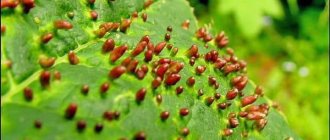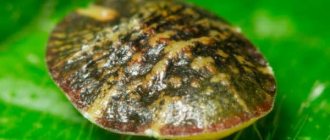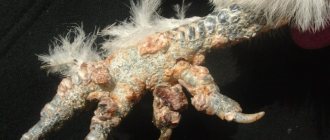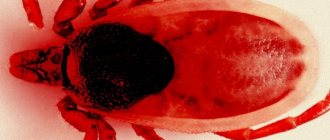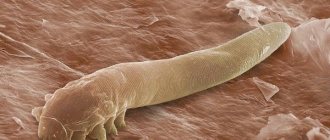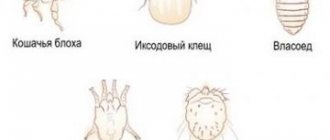Coniferous species are usually not widespread in urban plantings, but they are very widely represented in parks and forests of various natural zones of our country.
In general, the most severely damaged trees by insects are Scots pine, spruce and larch. Fir, Siberian cedar, Weymouth pine, prickly spruce (blue), thuja and juniper suffer much less from insects in parklands.
Foci of mass reproduction of pine-eating pests in parks and forested areas are not often formed, mainly when pests such as pine silkworms, pine cutworms, and pine moths penetrate from neighboring forests.
Sawflies damage pine, spruce and larch mainly in young (up to 20 years old) plantings.
At an older age, coniferous trees, weakened from various reasons, are attacked by bark beetles, longhorn beetles, borers and other stem pests, damage to which often leads to the trees drying out.
Pests of buds and needles.
Pine moth (lat. Bupalus piniaria).
Damages pine needles, rarely spruce and fir. Young caterpillars eat the tops of the needles, and adults eat the needles completely, leaving only the midribs. Caterpillars feed on old needles during July - September. When damaged again, trees often dry out.
Ways to fight:
- relocation of Formica ant colonies to pest breeding sites;
- spraying with 0.3% chlorophos solution is effective;
- raking litter in the second half of summer into heaps 1.5 m high and 2-3 m in diameter, with pupae overwintering in it, in which the pupae die;
- pollination of trees with calcium arsenic acid or soda fluoride (8-10 kg per 1 ha).
Fir moth (lat. Ectropis crepuscularia).
Harmful to fir. Caterpillars begin to eat needles from the lower tiers of the crown, rising upward. Severely damaged fir trees dry out.
The methods of fighting are the same as against the pine moth.
Pine armyworm (lat. Panolis flammea).
Caterpillars feed on buds, May shoots, young needles, and if there is a shortage of them, they also eat old needles.
The methods of fighting are the same as with the pine moth.
Pine silkworm (lat. Dendrolimus pini).
Early in the spring, overwintered caterpillars climb the trunk and begin to eat old needles. New caterpillars feed on needles in the summer.
Ways to fight:
- laying glue rings 4-5 cm wide and with a glue layer thickness of 3-5 mm, 40-50 kg of glue is consumed per 1 ha;
- pollination with calcium arsenic acid, 8-12 kg are consumed per 1 ha;
- installation of barrier grooves, 35x35 cm in size, around infected areas; the grooves prevent caterpillars from crawling into uninfected areas;
- attracting insectivorous birds.
Siberian cedar silkworm (lat. Dendrolimus sibiricus).
Harms various coniferous species, prefers Siberian cedar and larch. The caterpillars eat the entire needles with the sheath, and also damage young shoots. When the needles are partially eaten, the latter is restored, but the growth of the trees is weakened; with repeated damage, the trees dry out. Caterpillars eat the needles on a tree from top to bottom.
The methods of fighting are the same as with the previous species.
Silkworm nun (lat. Lymantria monacha).
It harms spruce and pine, and also damages larch, cedar, fir, and juniper. Selects mainly middle-aged and mature trees, but is also found on young trees. Caterpillars eat needles from the middle or even at the base, which is why the needles are often chewed through, their remains accumulate in large quantities under the trees. The caterpillars feed mainly on old needles, damaging the tree crown from its lower part, and then climb up. If larches are severely damaged, they lose annual growth and fruit yield.
Ways to fight:
- spraying with Parisian greens in a dosage of 10-15 g with double the amount of quicklime per 10 liters of water;
- pollination with calcium arsenic acid (8-12 kg per 1 ha);
- laying glue rings at a height of 1.3 m from the ground, first smooth the trunk bark, and then spread track glue, 32-40 kg of glue is consumed per 1 hectare;
- crushing caterpillars.
Pine sawfly (lat. Diprion pini).
It is the most harmful of the sawflies, damaging pine trees and most often attacking pine trees at the age of 10-25 years. The larvae stay in groups, eating the needles from the sides and not touching the midrib. Adult pseudocaterpillars eat the entire needles almost to the base. Second generation false caterpillars cause damage in August.
Large larch sawfly and small larch sawfly (lat. Nematus erichsoni).
The most dangerous is the first of these types. Young pseudo-caterpillars eat up the needles, usually leaving the midrib, and adult caterpillars eat all the needles, with the exception of the leaf sheath. When there is massive damage, the false caterpillars damage the bark of thin branches.
Red pine sawfly (lat. Neodiprion sertifer).
The larvae do damage in May - July, eating mainly old needles; during mass reproduction, they also damage young needles and the bark of May shoots, eating out irregular areas and gnawing shoots.
Spruce sawfly (lat. Pristiphora abietina).
False caterpillars eat the needles of shoots of young fir trees 10-20 years old.
Ways to combat sawflies:
- spraying with 0.2-0.3% chlorophos solution is effective;
- raking ground litter with sawfly cocoons into heaps and destroying them;
- autumn loosening of the soil to destroy false caterpillars that have left for the winter;
- pollination with arsenic acid calcium, fluoride and fluoride preparations against false caterpillars at the rate of 8-10 kg per 1 ha.
Spruce bud moth (lat. Gelechia electella L.).
The caterpillars first bore a spiral passage in the bast tissue, and then in the wood of the shoot, and eat away the lateral and then the apical shoots of the spruce. Due to damage to the apical shoot, the trunk becomes bent, and the damaged ends of the shoots dry out. Harms mainly young and rarely old trees.
Larch moth (lat. Сoleophora laricella).
Damages various types of larches. Caterpillars mine needles by first eating out the end of the needle, from which they then make a case for themselves. Damaged needles first turn white, then turn yellow and dry out.
Ways to fight:
- shaking caterpillars from trees;
- spraying trees with nicotine sulfate and soap before buds open;
- pruning and burning damaged shoots in autumn.
Ticks
Spider mites are one of the most ubiquitous pests. It affects almost all types of plants, except aquatic ones. You can notice ticks on larch, spruce and juniper along the web. Ticks are active in spring and summer, during which they may appear several times.
The size of individuals directly depends on their fatness, the length of females is 0.4-0.6 mm, males - 0.3-0.45 mm. Soft-bodied animals are characterized by an ellipsoidal shape, the upper part of the body is convex, the lower part is flat. Tick larvae are transparent, light green to green-brown in color, with 2 distinct, large dark spots on the sides. The color of females wintering from late summer to spring is orange to bright red. All adult ticks have 8 legs.
Spider mites feed on the contents of plant cells. The presence of the pest is indicated by a thin cobweb and the presence of small white dots on the needles. In case of severe damage, it turns completely white, the entire plant is covered with cobwebs, and a moving mass consisting of the bodies of parasites is visible on the needles.
The main prerequisite for the appearance of mites is low air humidity, so regular spraying of the outer parts of plants is a good prevention of the occurrence of the pest.
Control measures
The most effective way to get rid of ticks is to fight them with modern chemicals. Please note that spider mites are arachnids, not insects. It is useless to use insecticides against it.
It needs to be combated with other drugs - acaricides (Apollo, Flumite, Borneo, Floromite, Envidor) and insectoacaricides (Agravertin, Fitoverm, Akarin, Oberon, Actellik) . To destroy the most resistant individuals, it is necessary to treat with the selected drug several times.
Pests of branches and trunks.
Yellow spruce hermes and green spruce hermes (lat. Adelges laricis).
On spruce trees, their pricking and sucking causes ugly growth of tissue “galls”. The formation of a pineal gall leads to the death or curvature of the shoot, which is why young spruce trees with the loss of the apical shoot produce a crooked trunk. Massive damage affects growth and causes suppression of spruce.
Methods of control include pruning damaged shoots until the hermes emerge from the galls.
Pine subbark bug (lat. Aradus cinnamomeus).
Harmful to pine. The larvae feed under the bark scales throughout the summer and leave for the winter in the fall. Overwintered larvae feed for 2-3 weeks in the spring of next year and then turn into adult bedbugs. Bugs infest healthy pine trees at the age of 6-25 years. As a result of the sucking of bedbugs and their larvae, the needles turn pale, cracks appear on the bark, from which resin flows abundantly, and then resin ulcers appear. Silvery, gradually turning brown spots form under the bark. Affected plants are stunted, dry up, or dry out completely. The subbark bug prefers pampered, dry tree stands.
Methods of combating this include placing glue rings on the trunks.
Large pine weevil (lat. Hylobius abietis).
Damages pine, less often other conifers. The larvae make gradually widening passages under the bark down to the roots; under the thin bark they go deeper into the wood, the passages are filled with drill flour. The beetles that appear in early summer gnaw out small rounded areas in the bark of young trees during the period of additional feeding. The beetles damage pines up to 20 years of age, but pines under 7 years of age are especially affected.
Ways to fight:
- timely uprooting of freshly cut stumps;
- trapping grooves from which caught beetles are regularly selected;
- collecting beetles for bait from pieces (20-30 cm) of fresh spruce bark, pressed with a stone on the inside side to the ground; in pine forests you can lay out fresh logs and fresh branches, every five days the baits are inspected and beetles are selected from them;
- burying stakes from fresh poles in the bark to a depth of 1 m in the spring, leaving a top 10 cm high above the ground, sanding or burning the stakes in the fall destroys the larvae that have developed under the bark;
- laying out poisoned baits from fresh branches pollinated with arsenic salts of sodium or calcium.
Small pine weevil or point tar weevil (lat. Pissodes notatus).
Harms pine, less often - other conifers. Beetles overwinter under moss. In the spring, they gnaw small holes in the bark from which resin flows. The larvae gnaw through winding, expanding and diverging passages under the bark. Young beetles gnaw out round holes in the bark and emerge.
Ways to fight:
- timely care of young animals;
- cutting down infested trees and burning them until the beetles emerge;
- burying trapping stakes in an inclined position at a depth of 20-30 cm or specially withered (by ringing in winter) trapping trees and destroying them in the fall along with the weevils that have settled on them.
Large pine beetle or large forest gardener (lat. Tomicus piniperda).
Harmful to pine. Females gnaw through uterine ducts up to 10 cm or more in length. Young beetles make flight holes in the bark, emerge and climb into the crowns of healthy trees, where they feed additionally. During the period of additional feeding, the beetles pierce the core of young shoots and gnaw holes in them, causing the shoots to break off, and the beetles seem to be cutting off the shoots.
Control methods include selecting freshly infested trees, debarking them and destroying the bark before the larvae pupate, and uprooting fresh stumps.
Lesser pine beetle or lesser pine beetle (lat. Tomicus Minor).
Harmful to pine. The beetles gnaw out the core of young shoots, which causes them to break off.
The methods of fighting are the same as with the previous species.
Typograph or large spruce bark beetle (lat. Ips typographus).
They are predominantly inhabited by weakened, middle-aged and old trees. The most common and dangerous pest of spruce. Less commonly damages pine, cedar and larch.
Ways to fight:
- do not leave felled trees and tops with bark for the summer;
- remove trees fallen by the wind in autumn and winter, do not leave bark on them, completely debark them before June 1;
- remove dead wood annually, as it breeds bark beetles;
- Do not store firewood in parks or near tree plantations;
- carry out fire prevention measures (almost 80% of spruce stands turn into bark beetle even with a minor burn);
- carry out cleaning and thinning to prevent mass reproduction of pests;
- uproot affected trees and remove bark from stumps;
- lay out trap trees.
Double bark beetle (lat. Ips duplicatus).
The lifestyle is similar to the typographer, but the double inhabits younger and thinner spruce trees along the edges and well-lit places.
The methods of fighting are the same as with the printer.
Bark beetle engraver (lat. Pityogenes chalcographus).
Harmful to spruce, pine, cedar. Attacks weakened, mainly young and middle-aged trees.
The methods of fighting are the same as for the two previous types.
Black pine longhorned beetle and large black spruce longhorned beetle (lat. Monochamus galloprovincialis).
Harmful to pine, cedar, larch. Females gnaw out notches in the form of slits on the thin bark, and in the form of funnels on the thick bark, in which they lay eggs. The larvae first gnaw out irregular areas under the bark, then delve deeper into the wood. The passages are directed towards the center, then run parallel to the axis of the tree, from bottom to top, they are clogged with drill flour. Young beetles gnaw out a flight hole with a diameter of up to 8 mm and go outside. During the period of additional feeding, they gnaw the bark, cambium on thin branches, and pine needles. Beetles colonize weakened trees. Additional feeding from insects causes thinning of the crown and weakens the tree.
Methods of control are timely sanitary felling, laying out trap trees.
Country borer (lat. Ancylocheira rustica).
Damages pine and fir. Young caterpillars damage young shoots and branches, causing them to dry out and break off. Adult caterpillars damage thicker shoots. When attacked by a large number of caterpillars, thick branches and trunks die.
Ways to fight:
- careful supervision of young plants and timely removal of infected ones, as well as cutting off infected shoots with caterpillars;
- poisoning caterpillars with carbon disulfide by introducing balls of cotton wool or tow soaked in carbon disulfide into the caterpillar passages through holes in the bark, after which the holes are covered;
- attracting woodpeckers to the plantings, with nesting facilities for them.
Larvae of the large coniferous and small horntail (lat. Urocerus gigas).
Spruce, fir, and less commonly pine and larch wood are damaged.
Methods of control are the removal of dead, weakened and infected trunks.
Wintering shooter (lat. Rhyacionia buoliana).
The caterpillar bites into a kidney and hibernates at the site of damage. After overwintering, the caterpillar eats away the bud and damages the shoot, which leads to its bending and drying out.
Summer shootweed (lat. Evetria duplana Hb.).
The caterpillar bites into the shoot, makes passages in it, causing the top of the shoot to bend and dry out.
Middle bud shooter (lat. Blastesthia turionella).
The caterpillars burrow into the bud and overwinter there. Damaged shoots become bent and dry out.
Resin shooter (lat. Retinia resinella).
The caterpillars bite into the bark, and a layer of resin forms near the wound, in which the caterpillar overwinters. Shoots damaged by caterpillars become bent or die.
Shooters damage young pine plantations.
Ways to combat shoot shoots include pruning damaged shoots before the caterpillars emerge.
Sawflies
Spruce trees are attacked by sawflies:
- Canadian,
- Serbian,
- European,
- occasionally prickly.
As a rule, spruce trees do not suffer much from these parasites; next year their needles are restored. Sawflies cause more damage to pine trees; sometimes you can find entire nests of insects on the branches. Weymouth pine, cedar, mountain and common pine are most often attacked.
The insect's abdomen is connected to the thorax motionlessly, without the help of a stalk. The ovipositor of females looks like a saw, with which they cut plant tissue and lay eggs inside.
Externally, sawfly larvae look like caterpillars.
It is they who eat young shoots of coniferous plants from May to the end of June, after which the branches look scorched and die.
Controlling these pests is not difficult. The main task is to see the caterpillars in time and take measures to destroy them. “BI-58”, “Aktellik”, “Decis” and “Fury” will help with this.
Pests of seeds and cones.
Cone moth (lat. Dioryctria abietella).
Harms the cones of pine, spruce, larch and cedar. The caterpillars bite into the cone and eat the scales at their bases, as well as the seeds.
Cone leaf roller (lat. Laspeyresia strobilella).
Damages young spruce cones. The caterpillars bite into the cone, feeding on the core of the stem, scales and seeds; the cones become underdeveloped and become covered with resin. Caterpillars often destroy them completely.
Taring of pine cones (lat. Pissodes validirostris).
Damages pine cones by feeding on their contents. Damaged cones are underdeveloped and covered with resin.
Methods of control: collecting and destroying damaged cones before the beetles emerge from them (before May).
The pine cone beetle (lat. Ernobius abietinus).
It damages the base and stem of the cone, causing them to become covered with resin deposits and fall off prematurely.
Spruce cone beetle (lat. Ernobius abietis).
It sharpens the core and base of the scales of spruce cones, and in case of strong reproduction, completely destroys the seed crop.
Ways to combat cone eaters are to collect and destroy fallen cones in autumn and winter.
Hermes
Hermes are a special group of pests that attack pine and spruce. Parasites form on branches
trees, cone-like galls. There are several types of these pests. At the end of June, the early one is active, forming small oval galls at the ends of the branches. Yellow Hermes becomes active in August and develops large green galls. A late species of pest forms large spherical galls in late August-September.
Female Hermes feed on tree sap and lay eggs on them. The emerging larvae harm the kidneys, deforming them. Then galls develop in these places.
On the outside, these parasites are covered with a downy growth, making it difficult to combat them, for which systemic insecticides are used, for example, “Aktara” and “Commander”.
Bark beetles
Bark beetles can be called the most dangerous forest pests.
Most parasites live and develop under the bark of coniferous trees, less often in the thickness of the bark or in the wood, boring holes into them. Bark beetles are small, body length ranges from 0.8 to 12 mm, and the coloring of the pests is modest. At the end of the body there is a flattened bevel, which is bordered by teeth. This is a “wheelbarrow” used to remove waste from gnawed passages. By boring under the bark the so-called uterine duct, females lay eggs. The hatched larvae, in turn, gnaw their own, larval, passages in different directions from it. At the end of their move, they create a “cradle” chamber in which they pupate. Young beetles, hatched from pupae, gnaw flight holes through which they exit.
By boring under the bark the so-called uterine duct, females lay eggs. The hatched larvae, in turn, gnaw their own, larval, passages in different directions from it. At the end of their move, they create a “cradle” chamber in which they pupate. Young beetles, hatched from pupae, gnaw flight holes through which they exit. Mostly weakened, diseased, drying trees are attacked. Once colonized by pests, they die.
Pest control
Fighting bark beetles is quite difficult. Therefore, it is necessary, first of all, to carry out preventive measures that increase the overall resistance of coniferous plants. To combat the pest, pheromone traps are used, which are attached to the affected tree. All beetles located at a distance of 7 km flock to the smell. After this, the plants with bark beetles are uprooted and burned. Antipheromones can also be used to repel bugs. They are safe for animals and humans, unlike insecticides. Preparations used to combat bark beetles: “
BI-58
», «
Wofatox
».
Prevention of diseases of coniferous plants
In addition to pests, coniferous plantings can be threatened by various viral and fungal diseases. Scleroderria carcinoma is considered the most dangerous and common disease.
It affects the buds, shoots and needles of pine. Slow death occurs. The buds stop growing, the needles become reddish-brown and dry out. In the summer, grinding ulcers appear on tables.
The disease can be overcome by spraying trees with Abiga-Pik, Hom and Bordeaux mixture.
For planting, use only healthy seedlings that are free from pests, and also try to follow the rules of agricultural technology and carry out preventive measures.
Share with friends on social networks
Diseases and pests of coniferous plants and their control. As doctors often tell us, any disease is easier to prevent than to treat. This message applies to all living things and to conifers, including. Therefore, prevention cannot be neglected. And it begins from the moment of choosing a seedling.
We suggest you read: What to do if hermes appear on conifers
Preventive measures that are necessary for coniferous plants:
- When purchasing a seedling (it doesn’t matter if you buy it in a store, at a market, in a nursery, or dig it up in the forest), first of all, you need to assess the condition of the needles and branches. The shoots and trunk should not have damaged bark or streaks of resin, and the needles simply must be clean - without dried or yellowed areas, without plaque or stains. If a plant is bought on sale - with obvious defects, but cheap - it will require treatment and quarantine. Such a specimen cannot be immediately planted with healthy plants.
- Even if you brought a seemingly healthy seedling into your garden, spray it with a fungicide before planting for prevention. The fact is that many diseases have a long incubation period and the disease does not manifest itself immediately.
- Inspect your young conifers regularly. This is the only way to detect signs of disease or emerging pests in time. After all, the sooner the problem is detected, the easier it is to deal with it, and the greater the chance of the plant not dying.
- Healthy, well-groomed trees are less susceptible to attacks from all kinds of diseases and pests and can more easily cope with such troubles. Therefore, proper planting and care play a crucial role in disease prevention.
Mandatory, but simple care activities that you can do to give your conifers health:
- timely watering;
- applying seasonally appropriate root and foliar fertilizers;
- removing broken or damaged branches;
- mulching;
- preparation for wintering.
In order to prevent the fight against various pests, it is necessary to carry out a detailed inspection of the tree or simply periodically and with inspections.
Preventive methods include organizational, agrotechnical and forestry measures.
It will also be necessary to create a surveillance service that will monitor the appearance of pests and immediately take measures to prevent their spread.
The most favorable time for pest control is considered to be the period when caterpillar larvae appear. At this time, you can perform chemical treatment or try to collect the caterpillars by hand and burn them.
This will help prevent their further reproduction and growth. After carrying out all these activities, the tree needs special care. The pine tree must be fed with fertilizer.
Conclusion
If the pest is detected in time and the correct treatment measures are carried out, the tree will be reliably protected.
How to increase the immunity of coniferous plants?
A deficiency of essential microelements negatively affects not only the appearance of the plant, its general condition, development, but also its ability to cope with various diseases. Conifers suffer from insufficient supply of necessary elements as follows:
- there is not enough nitrogen - the needles grow poorly and have a pale color;
- iron deficiency - turn yellow and sometimes turn white;
- lack of phosphorus - they turn red.
To increase the immunity of coniferous plants, it is necessary to use fertilizers, preferably special ones for conifers. The fact is that ordinary mineral fertilizers sold in stores are intended for fruit and berry crops, and the application rates are calculated specifically for these plants. Conifers have different needs, and the standards for them are much lower.
When applying fertilizers, it is best to alternate root feeding with foliar feeding, which is often forgotten. But it is through the leaf (and the needles are precisely the leaves) that the plant better absorbs many microelements.
Do not forget that fertilizers containing nitrogen are applied only until mid-summer, since this element causes shoot growth. From the second half of summer, you can feed with phosphorus-potassium fertilizers with other microelements, excluding nitrogen - they will help the shoots to ripen, and the plant will successfully survive the winter.
Such preparations as “Zircon”, “Super Humisol”, “Immunocytophyte”, “Epin-extra”, “Nikfan” will help improve absorption and normalize the balance of microelements. These biological products also improve root formation, increase the immunity and resistance of plants to various stresses - bad weather, attacks by pests and diseases.
Morphological description
The pine sawfly (Diprionidae) is a family of sessile-bellied insects, including 140 species. Sawfly larvae feed on needles, causing significant damage to plants. A characteristic feature of the group of sessile bellies is a wide bridge between the chest and abdomen. The adult size is 6-10 mm. The body is oval, convex. Externally, sawflies are similar to wasps and bees; they belong to the same order - Hymenoptera.
Interesting fact. The name of the suborder “Sawflies” comes from the shape of the insects’ ovipositor. In most species it looks like a saw blade.
The photo shows that pine sawflies have clearly expressed sexual dimorphism.
Females are larger and their body color is yellow or brownish. Black spots on the back, scutellum and abdomen form variable patterns. The antennae are serrated and consist of 19-20 segments. The sawtooth ovipositor has denticles of various shapes and sizes. The male is smaller than his partner, his length is 6-8 mm. The body is completely black, only the legs are orange. The covers are smooth and shiny. The antennae are black-brown, feathery, with 18-20 pairs of comb-like processes. The head and thorax are covered with punctures and gray hairs. The hind wings are darkened along the edges.
Larvae
Adults do not feed; larvae store vital energy. They are called false caterpillars. Outwardly, they look like caterpillars - butterfly larvae. The difference is the large number of abdominal legs - 8 pairs, in caterpillars - 5 pairs. Body length 25-28 mm. Depending on the species, the color is green-yellow or dark gray with dark spots and stripes. The larvae live in large families of 2030 individuals. They feed together, and when the needles on the branch run out, they move to a new area.
Information. Male false caterpillars change through 5 instars, and female ones through 6 instars.
The excrement of pine sawfly larvae is distinguished by a peculiar diamond-shaped shape. When there is a significant spread of pests in the forest, a rustling sound is heard, caused by the fall of caterpillar secretions. A thin layer of waste can be found under the trees. The feeding period lasts from August to October. Most of the larvae then descend into the soil to pupate. Part of the colony hides in the bark, where it prepares to form a cocoon.
In this phase the larva is called an eonymph. Her body contracts and transforms, and her abdominal legs disappear. The insect cocoon is cylindrical in shape, with blunt, rounded ends. Brown color. The larvae of the first generation spend several days in the eonymph state, and the second - 8-9 months. They survive the winter months while in a cocoon.
